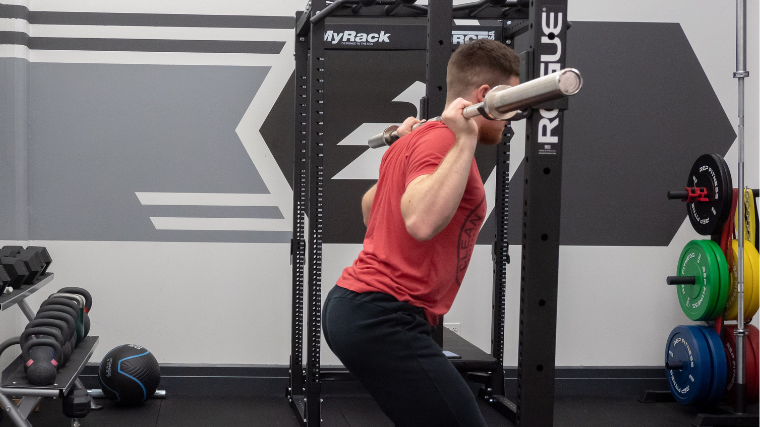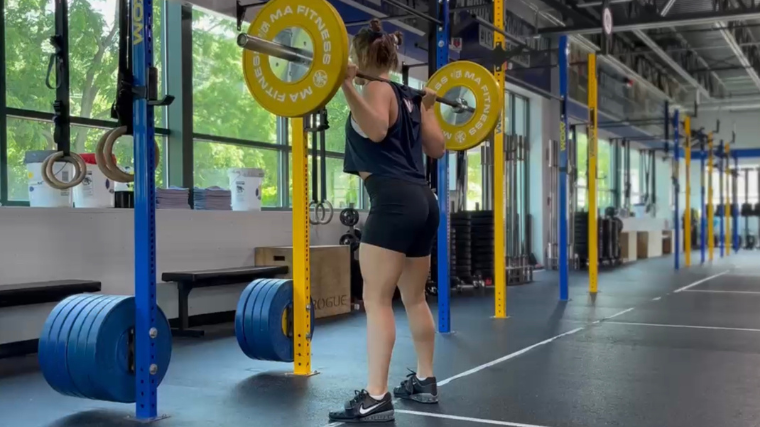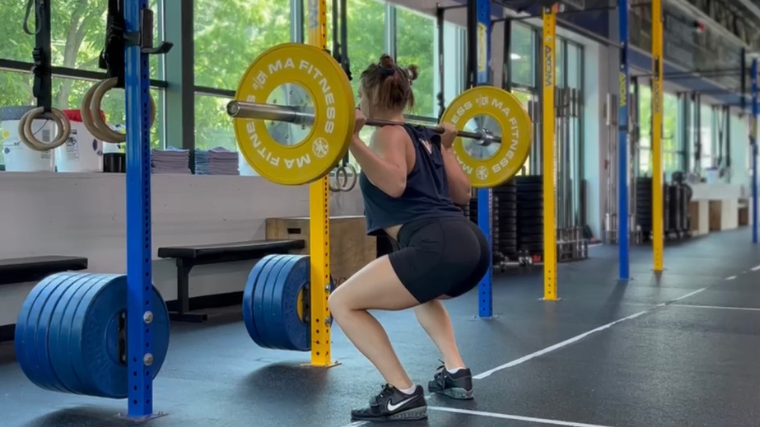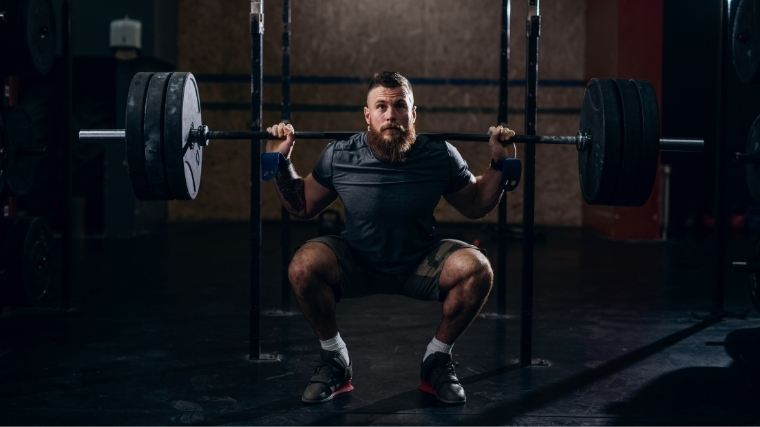Fresh-faced gymgoers and world-class strength athletes don’t have a lot in common, but there’s one throughline that matters — the squat is integral to both of them. Regardless of which camp you fall into, or what your fitness goals are, few exercises get you where you need to be like the back squat.
Bodybuilders squat to build up their legs. Powerlifters squat because they have to. Runners, martial artists, and military personnel all squat as well, just for different reasons. No matter your “why”, the back squat deserves a seat at the table in your exercise routine.
There are different squat styles — and both present different mechanics that new and experienced lifters alike have to wrap their heads around.
The payoff for learning this movement — bigger quads, more power, and bragging rights to your gym buddies — however, is well worth the time spent mastering it.
- How to Do the Back Squat
- Back Squat Sets and Reps
- Common Back Squat Mistakes
- How to Warm Up for the Back Squat
- High Bar vs. Low Bar Back Squats
- Back Squat Variations
- Back Squat Alternatives
- Muscles Worked by the Back Squat
- Benefits of the Back Squat
- Who Should Do the Back Squat
- Frequently Asked Questions
Editor’s Note: The content on BarBend is meant to be informative in nature, but it shouldn’t take the place of advice and/or supervision from a medical professional. The opinions and articles on this site are not intended for use as diagnosis, prevention, and/or treatment of health problems. Speak with your physician if you have any concerns.
How to Do the Back Squat
Before you step into the squat rack, know that there’s more than one “style” of squatting. Powerlifters rely on the low bar squat — resting the barbell across their upper back and shoulders, rather than directly on their traps — while the “standard” technique places the bar up higher.
This guide will instruct you on how to perform the high bar squat.
Step 1 — Set Your Base

Start by stepping under a barbell (supported in a squat rack), setting a firm foundation by flexing your core, and preparing to lift the barbell out of the rack.
While you will need to step out of the rack to set your stance for the squat, you should place your feet in your squat stance, or slightly narrower, so you can “squat” the load out of the rack, rather than stepping in and out with one foot.
Coach’s Tip: The tip here is simple — do not rush this process. Press your traps firmly into the bar and brace that core!
Step 2 — Get a Grip

Where to hold the barbell varies person-to-person — but not by much. There will be two rings on the knurling on most quality barbells, on either side of the bar, about six to eight inches from the base of the sleeve. Use that as a guide by placing your fingers on it and seeing which width feels the most comfortable. For some, it’s the ring finger, while others favor the middle finger.
Once you find a comfortable hand position, grip the bar tightly by wrapping your thumb around it. Bring your elbows down and in, so they’re close to your lats. This down-and-in elbow position will help you pull the barbell onto your trap and create a stable “shelf” for the bar to sit on. (For low-bar squats, you’d position the barbell more on the rear delts and lower traps.)
Coach’s Tip: Don’t over-arch your spine. Your back should be mostly flat, but there’s no need to obsess over it significantly.
Step 3 — Set Your Stance

Perform a partial squat to remove the barbell from the rack. Take one step backward with each leg, and then realign your feet. Your stance should be roughly hip-width apart, with your toes pointed as forward (or as turned-out) as is comfortable. Your weight should be evenly distributed across your foot, and your gaze fixed straight ahead.
Coach’s Tip: You should have taken a breath in before removing the barbell from the rack. Hold that air as you step backward into your squat stance and then recycle a new breath before squatting.
Step 4 — Sit Straight Down

From a standing position with your eyes looking forward, inhale deeply, brace your core, and then sit straight down. You can think about trying to sit your pelvis directly between your feet. Sink as low as your flexibility or comfort allows — you should aim to get your thighs roughly parallel to the floor.
Coach’s Tip: Contrary to some popular fitness myths, it is perfectly okay for your knees to drift ahead of your toes, as long as your entire foot stays firmly planted on the ground.
Step 5 — Explode Up

Once you’ve hit the bottom of your range of motion, reverse the movement and return to a standing position. Push with your legs and try to ascend with the same posture you sat down with. Don’t shoot your hips backward or tilt your torso down. At the top, simply think about standing up — there’s no need to dramatically flex your glutes.
Coach’s Tip: New squatters should consider pausing at the bottom of their range of motion to get comfortable with the posture.
Back Squat Sets and Reps
As the back squat is relevant for just about every flavor of fitness enthusiast, how you go about programming it matters a great deal with respect to what kind of returns you’re looking for.
Here are a few different ways to program the back squat, but take note — the more specific your goals become, the more nuanced your squat training will be as a result. Use these as what they are: generalized prescriptions.
- To Build Muscle: 4 to 5 sets of 6 to 8 reps with a moderately heavy weight.
- To Gain Strength: Anywhere from 3 to 8 sets of 3 to 5 reps with a heavy but manageable weight.
- As a Beginner: 3 sets of up to 10 reps with a light weight to work on technique.
Common Back Squat Mistakes
The back squat is equal parts simple and complex. It’s one of those exercises that feels insurmountably difficult when you’re first learning but, over time, can become as natural as walking. Still, there are a few pitfalls to be wary of, especially if you’re just finding your proverbial footing in the movement.
Half-Squatting
If you’re not a powerlifter, how low you squat doesn’t technically matter. That said, when it comes to depth, more is more, almost universally. Many learners will cut their descent short on the back squat out of fear, movement anxiety, or inflexibility. You should strive to sink as low as you can while squatting unless you have a restriction or injury.
Hips Shooting Up
When you reverse the descent and push yourself out of the bottom of the squat, the angle of your torso should remain consistent from start to finish. If your back is stronger than your legs or you try to stand up too quickly, you run the risk of keeling over as your pelvis shoots out behind you.
This can throw you off balance, screw up your “groove”, and sap you of your power output. Stand up with your hips and legs equally.
Overusing Your Glutes
Believe it or not, it is possible. The back squat is a phenomenal glute builder, but there’s no reason to over-emphasize it. You may occasionally see people stand up out of their squat and really thrust their hips forward at the top, squeezing their bums as hard as they can.
This may look effective, but it doesn’t work your glutes any harder. Since your hips are so close to the weight already, there is little tension on your glutes at the top of the back squat. If you want to increase glute activation on the squat, make sure you’re breaking parallel at minimum.
Shifting Your Weight
Most people don’t need to adjust, tweak, or tinker with their foot pressure in the squat. Your goal is to be balanced at all times, with your body’s weight evenly-distributed across your whole foot.
As you learn to squat, you may find that you shift forward onto your toes or backward onto your heels — strive to stay in the middle the whole way through.
How to Warm Up for the Back Squat
A great warm-up is a must before getting under the barbell, especially if you plan to lift heavy. Some lifters like to warm up by performing lighter barbell squats, while others prefer to use scaled exercises before getting under the barbell.
There are multiple ways to warm up for squats, and regardless of what you prefer, it’s a must to prep the body properly before loading it. If you need some squat warm-up ideas, elite Swedish powerlifter Isabella Von Weissenberg can show you what it takes to get your game right:
High Bar vs. Low Bar Back Squats
The differences between the high-bar and low-bar squat aren’t as stark as you might think, but they do matter and can affect how you choose your preferred style of squatting.
Bar Placement
For high bar squats, the barbell rests right on the “meat” of your trapezius muscles. This places the resistance a bit closer to your center of mass, which enables a more upright posture.
When you squat low bar, you “lock” the bar into place across your rear deltoids and upper back. This will naturally fold your torso over slightly, even while standing, but does allow you to lift a bit more weight.
Joint Mechanics
The placement of the barbell is what affects how you move with it. High bar squats will generally create a more upright torso, while low bar squatters fold themselves over more.
However, neither of these things are a conscious element of the technique that you should “try” to achieve. Whether you squat low bar or high (or front, or Zercher, or…), you should still think about maintaining balanced foot pressure and using your knees and hips in tandem.
Generally speaking, you’ll just notice a bit more stress on your legs with the high bar squat, and more tension on your back and hips during low bar.
Back Squat Variations
Below are three back squat variations that you can do to improve your strength, form, and power.
1 1/2 Squat
[Related: Best Home Gym Squat Racks on the Market]
The 1 1/2 squat entails performing a full rep, then a half rep, then finishing. This variation is great for increasing time under tension, improving postural positions, and sharpening mental awareness during the squat. Be warned, though: this one burns.
Pause Back Squat
The pause squat is identical to the standard back squat in every way save one — you come to a full stop in the bottom of your range of motion. Pause squats are great for developing isometric strength, improving your hip or ankle mobility, and teaching yourself how to develop explosive power.
Tempo Back Squat
[Related: How to Build Your First Workout Program]
Tempo training during the back squat can improve muscle growth, increase angular strength and coordination, and improve your awareness and understanding of balance and positioning during the squat. To do this, choose a cadence (for example, two to four seconds) and stick to it as you descend.
Back Squat Alternatives
Below are three back squat alternatives that can be used to improve leg strength, muscle hypertrophy, and posture.
Goblet Squat
[Related: The Untold History of the Back Squat]
The goblet squat is a fantastic back squat alternative for the beginner that wants to nail down their movement mechanics. Besides being a fantastic precursor for back squats, the goblet squat is a great exercise to do during warm-ups and when teaching torso positioning.
Split Squat
While not traditionally done with a front rack position (however it can be), the split squat is a great unilateral exercise to develop quadriceps strength and muscle mass. This exercise can be used as an accessory movement to increase front squat and lower body performance.
Hack Squat
The hack squat machine is an excellent alternative to the back squat as it helps emphasize quadriceps growth via increased knee flexion. This is ideal for lifters who need additional quadriceps development yet may be limited by their mobility, upper back strength, or a combination of the two. The hack squat can be done using tempos, pauses, and double pauses to really maximize growth.
Muscles Worked by the Back Squat
Below are the muscle groups involved with the back squat. The back squat is a very taxing compound exercise that takes just about every muscle in your lower body to the limit.
Quadriceps
The quadriceps extend your knee joint and, as a result, are the prime mover in every form of squat you perform. The deeper you sit into the squat posture, the more your knee bends. As such, you’ll generally get more quad engagement the deeper you squat, so don’t skimp out on your depth.
Glutes
Your glutes help control the rate at which you descend into the squat. More importantly, they help you extend your hips and return to a standing posture.

Your gluteus medius (and minimus, to a degree) also play a role in controlling the angle and rotation of your thigh so your technique stays on-point.
Spinal Erectors
The spinal erectors work to maintain an upright torso position in the back squat. Like the front squat, the erectors work to maintain a vertical torso position to allow for a more quadriceps-focused high-bar back squat. Your erectors are stressed more in the low bar back squat than when working high bar, which is worth considering when you’re picking your preferred squat.
Core
The musculature of your core enables the squat. If your legs are the engine, your trunk is the frame that allows you to produce power and move well. You’ll notice a great degree of abdominal engagement if you squat with a high bar or front position, as your abs need to work double-time to maintain a vertical posture.
Benefits of the Back Squat
Below are three main benefits of the back squat. It’s important to note that back squats are one of the most beneficial exercises (when done correctly and not in excess) for strength, sports performance (especially in strength and power sports), and leg strength.
Improved Leg Strength and Size
The back squat, like the deadlift, builds serious leg and back strength as it engages all major muscles in your legs — big and small — and allows you to load the body with significantly more weight than what can be achieved with other moves like lunges, goblet squats, and leg extensions.
More muscle is aesthetically pleasing. After all, no one (well, most people) wants to look like Hercules up top and the Road Runner from the waist down. Also, while a bigger muscle doesn’t necessarily mean a stronger muscle, it does mean you have the capacity for more strength.
(Way) More Power
The squat patterning and performance outcomes have been linked to an athlete’s ability to jump higher and sprint faster. One study in the British Journal of Sports Medicine found a strong correlation between squats (well, half squats) and jump height. (1)
If you’re an athlete, you may want to (strongly) consider adding squats to your strength training routine.
Improved Movement
Almost everyone engages in squats, or some for of them, daily. Where do you think the expression “pop a squat” comes from? When it comes to moving, if you don’t use it, your body will eventually lose it, so to speak.
Your joints need to engage in a specific pattern on the regular to become proficient at it, and so back-squatting will help your ankle, knee, and hip joints get better acquainted with this movement pattern, which is a good thing if you don’t want to be stuck on the toilet in your 80’s.
Who Should Do the Back Squat
The squat isn’t the end-all, be-all of resistance training, but it’s close. The movement pattern is one of the most fundamental skills available to human beings, making it as close to a gymgoing essential as an exercise gets.
Powerlifters
The squat is the first of three competition lifts that comprise a powerlifter’s Total, followed by the bench press and deadlift. Powerlifters almost exclusively employ the low bar squat as it allows the athlete to achieve a heavier one-rep max.
Strongman Athletes
Squatting isn’t as prominent in strongman as it is in Olympic lifting or powerlifting, but you still need strong legs. Challenges like the Atlas stones absolutely necessitate explosive quad strength, so strongmen should dedicate some of their training resources to building up their back squat.
Weightlifters
The competition lifts for Olympic lifting are the snatch and clean & jerk. The high bar back squat is critical for both leg strength and torso posture as an accessory, while the front squat is directly transferable to your performance in the clean.
CrossFitters
Competitive fitness training and competitions, like the CrossFit Games or otherwise, involve many movements such as the snatch, clean and jerk, jumping, and other upright squatting movements. They also involve a good deal of pulling movements that require serious hip and back strength.
Bodybuilders
If you’re pursuing the “perfect” physique, lifting weights is all about finding which leg exercise best suits your body and gives you a good mind-muscle connection.
However, load and tension are still important for hypertrophy. The back squat definitely has a place in any good leg day, but you shouldn’t force the issue if you don’t connect with the movement.
Start Squatting
Squatting is the metric by which your fitness is measured. Squatting to depth (and re-racking your weights) is a hallmark of good gym etiquette and signals that you take your training seriously. For strength athletes, the back squat is either an invaluable accessory movement, or a cornerstone of the sport itself.
No matter your “why”, when it comes to squatting, there are (almost) no good answers to “why not?” If you’re looking to improve your strength, posture, build bigger legs, or make the most of your limited time in the gym, the back squat is one of the best avenues you can take to reach your goals.
FAQs
Who should back squat?
The back squat is an interesting exercise because it holds benefits for every lifting population, however, not everyone needs to perform this exercise to progress. However, if you’re able to and comfortable in doing so, then regularly using the back squat is a fantastic tool to develop total body musculature.
What are the benefits of the back squat?
The back squat holds multiple benefits for every fitness enthusiast. Some of the most popular benefits include:
- Improve lower back strength.
- Increase lower body power.
- Build a strong core/torso (due to stabilization of weight).
- Sharpen body awareness and coordination.
- Build resiliency in sport and daily life.
Can beginners back squat?
Absolutely! However, it’s worth noting that true beginners should seek out a coach when first learning the back squat. It’s never a bad idea to have someone watch and critique your form when starting out, but yes, everyone — ever true beginners — can back squat.
What muscles do back squats work?
The back squat works a variety of muscles and this is why most call it the “king” of the lifts. Some of major muscle groups squats work include:
Primary Muscles
- Glutes
- Quads
- Adductors
Secondary Muscles
- Obliques
- Rectus Abdominis
- Erector Spinae
- Calves
- Hamstrings
- Traps
References
1. Wisløff U, Castagna C, Helgerud J, et alStrong correlation of maximal squat strength with sprint performance and vertical jump height in elite soccer players British Journal of Sports Medicine 2004;38:285-288.
Featured image: Riley Stefan
The post Master the Back Squat for Superior Strength, More Leg Muscle, and Better Movement appeared first on BarBend.

